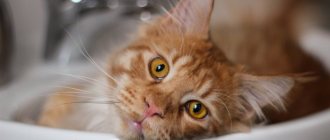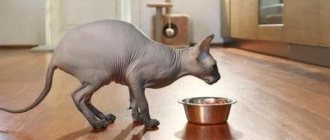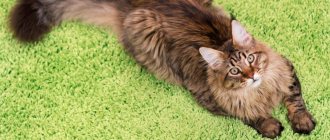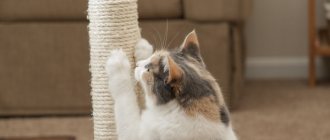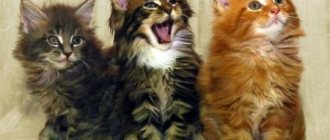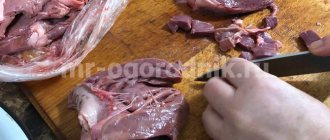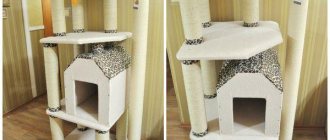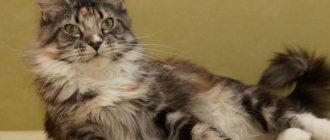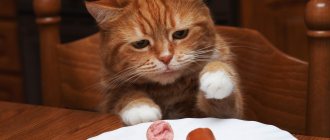The Maine Coon is very popular today. Its main differences from other breeds are its large size and weight. The main condition for the good appearance and health of your beloved pet is proper and balanced nutrition. Given the size of the pet, a special diet and regime is required that must be followed, so the question of what to feed the Maine Coon is very important for owners.
Natural nutrition.
Content
- Basics of a healthy diet
- Natural nutrition Healthy food
- Junk food
- Balanced composition and daily requirement
- "Kunya porridge"
- Dry food
- Age factor
- Feeding with natural products
General rules
When feeding a Maine Coon, it is important to adhere to basic rules and remember that the characteristics of the diet depend on their age. If you follow all the recommendations, you will not have any problems with your cat's health.
- When feeding your kitten, introduce new food gradually, giving him new foods in turn.
- Do not get carried away with dry food - it adversely affects the cat's health.
- If you do give dry food, make sure your cat or kitten drinks plenty of fluids.
- Monitor your pet's weight. A weight gain of 400 grams is considered normal.
- Under no circumstances should you feed your Maine Coon anything that is not suitable for them or that is harmful to their health.
Basics of a healthy diet
The main principle that cannot be neglected: food prepared for family members is not suitable for feeding a four-legged friend!
This is due to:
- characteristics of the animal’s digestive system;
- a specific set of enzymes;
- the difference in vitamin-mineral, energy needs of the human and cat body.
Food “from the table” is poorly digested by pets, causing gastrointestinal disorders, liver and kidney diseases, and developmental disorders.
Before creating a diet for your ward, you should choose one of two feeding options. Suitable daily menu:
- Natural food prepared taking into account the physiological characteristics of the animal. The main ingredient in cat dishes is lean meat.
- Ready food. It has a balanced composition and is available in dry and wet form. Sold in pet stores and special departments of supermarkets.
Proper nutrition contributes to:
- normal formation of the skeleton and muscular system;
- good condition of teeth, claws, coat;
- strengthening immunity, preventing diseases;
- establishing contact with the owner;
- increasing life expectancy.
Castration and sterilization
The female Maine Coon is ready to breed at a fairly early age - sometimes as early as 8 months. An unsatisfied instinct makes the animal suffer, it can even get sick, but in general, in this breed the desire to reproduce is expressed by rolling on the floor and loud screams. It’s a little easier with cats - they simply mark their territory, which, however, is also unlikely to please the owners. If keeping a pet in your home does not involve mating, it is better to immediately take measures to allow the animal to forget about instinct.
With cats, the situation is a little simpler, since castration, that is, removal of the testes, takes only 5-7 minutes, and does not even involve stitches. For a cat, the procedure can take on different scales - she may have either her uterus or ovaries removed, or both, because of this, the duration of the operation can vary markedly, ranging from 10 to 20 minutes. Since such an intervention is a priori more complex, sutures are mandatory; after one and a half to two weeks you will need to visit the veterinarian again to have them removed.
Natural nutrition
You can feed a Maine Coon with natural food only if the owner has time to prepare special dishes.
Healthy food
The table provides a list of foods that should be included in the Maine Coon’s diet:
| The product's name | Useful composition | Feeding features |
| Meat: beef, chicken, turkey (without skin), rabbit, lamb (lean), horse meat. | Proteins (16–20%); vitamins A, D, E, H, PP, group B; calcium, magnesium, potassium, sodium, phosphorus, iron, chlorine. | You can give it boiled or raw, after keeping it in the freezer for 3-5 days. Sometimes it is allowed to diversify the menu with low-fat meat broth. |
| By-products: liver (in small quantities), heart, tripe, udder, stomach. | Proteins; vitamins A, E, PP, group B; calcium, magnesium, potassium, iron, copper, zinc. | Served boiled. |
| Vegetables: carrots, zucchini, pumpkin, cauliflower. | Vitamins A, B1, B2, C, D, E, K, PP; calcium, magnesium, phosphorus, potassium, sodium, iron, manganese, copper, zinc. | Can be given raw, boiled, baked. |
| Greens: parsley, dill, lettuce. | Vitamins A, B1, B2, C, E, K, PP; calcium, potassium, phosphorus, iron. | Add to meat and vegetable dishes. |
| Porridge: oatmeal, rice, buckwheat. | Vitamins B, E, K, PP; calcium, phosphorus, potassium, magnesium, sodium, sulfur, iron, zinc. | Serve porridges cooked in water or low-fat meat broth with finely chopped meat and fresh herbs. |
| Sea fish: hake, pollock, lemonema, etc. | Proteins; vitamins A, B, C, D, E, K; phosphorus, potassium, sodium, magnesium, calcium, iron, sulfur, chlorine, manganese, copper, iodine, zinc, fluorine. | Offer boiled no more than 1-2 times a week. |
| Eggs: chicken, quail. | Proteins; vitamins A, groups B, D, E, K, PP; calcium, potassium, magnesium, sodium, phosphorus, iron, copper, manganese, selenium, zinc. | Serve chicken eggs (yolks) hard-boiled. Quail - can be given whole raw. |
| Fermented milk products (low-fat): kefir, yogurt, cottage cheese, fermented baked milk, acidophilus, Varenets. | Beneficial bacteria; vitamins A, group B, C, D, D3, E, K, PP; calcium, potassium, phosphorus, magnesium, sodium, selenium. | Offer fresh product at room temperature. |
| Vegetable oil: sunflower, olive, flaxseed | Fats; vitamins: A, group B, D, E, K; potassium, calcium, phosphorus, sodium, omega-6, omega-9 fatty acids. | Add ½ tsp to porridge and vegetable dishes. for one serving. |
Junk food
The table provides a list of foods that should not be included in a cat’s diet:
| The product's name | Why should you not include it in your diet? |
| Fatty meat: pork, duck, goose | Causes functional disorders of the stomach and intestines. Frequent feeding of this product can cause severe disturbances in the cat’s digestive system and lead to the death of the animal. |
| Bones | Injury to the organs of the gastrointestinal tract. |
| Milk | Causes indigestion. |
| Potato | When boiled, it is a useless product. Raw potatoes are harmful due to their high starch content. |
| Tomatoes and eggplants | They cause stomach pain due to the presence of alkaloids in vegetables. |
| Beans | May cause bloating and flatulence. |
| Onion and garlic | They are a source of disulfides - substances that destroy leukocytes |
| Mushrooms | Difficult to digest and toxic to the cat's body. |
| Avocado | Causes gastrointestinal disorders due to the content of persin, which is toxic to Maine Coons. |
| Nuts | High phosphorus content contributes to impaired hematopoiesis, calcium loss, and the development of liver and kidney diseases. |
| Pasta | May cause gastrointestinal colic |
| Flour products | Causes bloating and diarrhea. |
| Sweets | Promotes obesity, metabolic disorders, and tooth decay. |
| Salty dishes | They form an electrolytic imbalance, increasing the risk of diseases of the heart, digestion, and muscular system. |
Foods that should be given to your Maine Coon with caution and in limited quantities:
- Fish. Feeding fish dishes more than 2 times a week can cause diseases of the genitourinary system.
- Eggs. Contain a large amount of cholesterol. Frequent use of this product during feeding is fraught with disorders of the digestive system and gall bladder. Raw eggs should not be given due to possible salmonellosis infection.
- Carrot. Carotene present in the composition contributes to the appearance of a yellow tint in the coat of light-colored cats.
Balanced composition and daily requirement
The goal of proper nutrition is to provide the living body with the necessary substances and calories, avoiding pathological deviations in body weight.
The Maine Coon should be fed according to established standards: for a cat to grow large, 60 kcal and 10 g of protein are required per 1 kg of weight. The composition of natural food must correspond to the following indicators (per 100 g):
- protein – 20–45%;
- fats – 10–30%;
- fiber – 2%;
- energy value – 300–400 kcal.
A Maine Coon that has reached the size of an ordinary cat eats approximately 250 g per day. Accordingly, the number of main products offered during the day will be as follows:
- meat (or fish) – 60–120 g;
- cereals – 10–20 g;
- vegetables – 20–50 g;
- fermented milk products – 20–60 g.
When the Maine Coon finally grows up, the amount of food will need to be increased by 1.5–2 times.
An adult Maine Coon should be properly fed 2 times a day, dividing the daily portion into 2 parts. It is necessary to ensure that there is always a bowl of purified drinking water in the cat’s territory (boiling is not recommended).
"Kunya porridge"
One of the options for natural balanced food for Maine Coons is “kunya porridge”. The general composition of this dish is as follows:
- Meat products – 80%.
- Additives – 20%.
Meat products:
- meat (beef, turkey, chicken, rabbit);
- offal (heart, liver, stomach, tripe, udder, lung).
Additives:
- fermented milk products (kefir, yogurt, yogurt, cottage cheese, cheese);
- chicken eggs (yolks);
- vegetables (carrots, zucchini, cauliflower, pumpkin);
- greens (parsley, dill, lettuce, kelp);
- vegetable oil (sunflower, olive, flaxseed).
Based on these products, you can create various cooking recipes. One of them is presented here.
Ingredients:
- beef – 1 kg;
- beef liver – 500 g;
- beef kidneys – 500 g;
- veal heart – 500 g;
- light veal – 500 g;
- turkey fillet – 1 kg;
- chicken necks – 1 kg;
- chicken stomachs – 500 g;
- chicken necks – 1 kg;
- carrots – 4 pcs;
- zucchini (or pumpkin) – 1 kg;
- wheat bran – 500 g;
- kelp – 50 g.
Cooking method:
Cut the beef and turkey fillet into small pieces, and grind the offal in a meat grinder. Add the chopped herbs and mix everything. Divide the resulting mixture into bags and place in the freezer for 3-4 days. Before serving, add kefir or yogurt (without additives).
About the breed
Maine Coons are also called American Coon Cats, probably because that's where they come from. This breed gained fame back in the 19th century, and since then it has been given the palm in popularity only once - to the fluffier Persians.
There was even a period when Maine Coons could have disappeared altogether as a species , but thanks to their impressive appearance and excellent hunting abilities, they managed not only to survive, but also to take first places at exhibitions.
Today, the Maine Coon is one of the most popular breeds. And it’s not just their unusual appearance – these cats have an unusually kind character. The formidable beast is actually more similar in character to a plush toy: it will never scratch you and can’t even meow loudly.
In terms of care, only the claws and fur require special attention, but the food ration is quite simple for adults; with babies you will have to tinker.
As you can see, feeding your pet is quite a troublesome task, and requires from the Maine Coon owner not only attentiveness and patience, but also quite large financial expenses. Professional food is not so cheap, but it is better to spend money and have a beautiful, healthy cat in your home, whose fur will be soft and silky, whose health is normal, and whose mood is always high.
If you want him to grow up big and beautiful, take care of your Maine Coon like a member of the family, and he will reciprocate.
But in everything you need to know when to stop. It’s better to find out in advance how many times to feed, especially for a small kitten, since too much weight gain is also not good. Animals can also become obese, and this is just as bad as it is for humans.
Vitamins and minerals
A natural diet does not always meet the standards of a balanced diet. To compensate for the lack of active substances, it is recommended to use vitamin and mineral supplements. The need for them is increasing:
- during a period of active growth;
- during illness;
- under stress;
- during the molting period;
- during pregnancy and feeding;
- in the autumn-spring season.
A veterinarian will help you choose a suitable complex, taking into account the individual characteristics of the animal. To prescribe certain additives, the following factors are taken into account:
- pet's age;
- appearance;
- emotional condition;
- behavioral characteristics;
- results of biochemical tests.
The table contains general recommendations for the use of vitamin and mineral supplements:
| What is the purpose of the additive? | What medications are needed |
| For proper growth and development (up to 6 months) | Complexes with high calcium content. |
| For bone strength | Calcium and phosphorus supplements. |
| For the beauty of wool | Preparations containing vitamins A, D, group B and calcium. |
| To improve digestion | Vitamin complexes with taurine. |
| To improve visual acuity | Vitamin complexes with taurine. |
| For a successful pregnancy | Supplements with calcium, phosphorus, iron, vitamins A, E, D, group B. Special preparations based on spirulina (a rich source of folic acid). |
| For well-being in old age | Preparations containing calcium. Vitamin B6 (stimulates brain function). Herbal supplement based on ginkgo biloba. |
| For the prevention of urolithiasis in castrated animals | Multivitamins with taurine and calcium. |
There are various forms of vitamin and mineral supplements:
- pills;
- capsules;
- pastes;
- powders.
Many vitamin products have a pleasant taste, so cats eat them with great pleasure. If the pet refuses to take the drug in its pure form, it is added to the food (the tablets are pre-crushed).
Description of the breed, character and habits
The breed belongs to the group of semi-long-haired cats. There are many versions regarding its origin. According to one legend, these animals arose as a result of intercourse between a cat and a female raccoon, from which Maine Coons inherited their unusual size and striped tail. The second version indicates that these pets appeared after intercourse with the North American lynx. However, both stories are nothing more than fiction, since it is impossible to obtain offspring as a result of interspecific crossing.
The truth is that Maine Coons are the natural population of the cat metropolis. The peculiarities of formation were determined by nature, which made the animals physically large and hardy in order to survive in the harsh winter conditions.
Indeed, the peculiarity of these cats is their size. An adult cat reaches a weight of 10–15, and a female – 6–8 kg. They develop slowly, reaching maturity by 4–5 years.
Maine Coons are very easy to care for, despite their gigantic size.
The animal's head is trapezoidal in shape, slightly narrowed in width and elongated in length, and the profile is slightly curved. The ears are set high, with tufts at the top. The body is muscular, reaches a length of 1.2 m. The neck is of medium length, the chest is wide. The limbs are large and muscular. There are tufts of wool between the toes on the paws. The size of the tail corresponds to 2/3 of the body length. The eyes are oval shaped. Their color can be green, golden, amber, yellow.
The coat is thick and silky. It consists of two layers: the first of them provides protection from cold, the second from moisture. The areas on the belly, back, collar area and sides are covered with the longest hair. The color can be varied. Only chocolate, lilac and fawn colors do not meet the standards. The lifespan of Maine Coons is 12–20 years.
Cats are calm, balanced and attached to their owner
In addition to their external appearance, an attractive feature of cats is their friendly nature and high level of intelligence. These animals have the ability to remember words and distinguish intonation, making them easy to train. They don’t really like to lie on their owner’s lap (with rare exceptions). But they prefer to spend time next to him. The Maine Coon can follow its owner wherever he goes.
As children, they have a playful character. But adult cats are calm and reserved. Animals do not immediately trust people. It will take some time to establish contact with them. It won't be difficult to train them to walk on a leash.
An amazing fact is the peculiarity of their voice. When meowing, these giant cats make a very thin sound, which introduces a certain imbalance with the impressive appearance of the animal.
Feeding with prepared food
If you have a shortage of free time and for a more balanced diet, you can use ready-made food. They contain all the necessary substances in optimal proportions. The main condition for the successful use of an industrial product is its compliance with high quality. This is the feed class:
- "premium";
- "super-premium";
- "holistic".
According to veterinary standards, the quantitative ratio of nutrients in the finished product should be as follows:
- proteins – no less than 26%;
- fats – 9%.
High-quality food contains the following components:
- natural meat (up to 70%);
- offal;
- herbal supplements (herbs);
- cereals (absent in some foods).
In order not to make a mistake in your choice, you need to buy food in original packaging. The product is of high quality if the information on the box or package meets regulatory requirements:
- the first in the list of ingredients is meat indicating its variety (beef, turkey, chicken, rabbit);
- the product contains no artificial preservatives;
- products o, “Superpremium”, “Holistic”.
Depending on the consistency, industrial feeds are divided into 2 types:
- dry;
- wet.
Dry food
Advantages:
- Has a long shelf life without special conditions.
- Can stay in the cat's bowl for 24 hours.
- Reduces the likelihood of tartar formation.
- Indispensable when traveling.
- Costs less than wet.
One of the disadvantages of dry food is the lack of moisture, so when using it, you should provide your pet with the necessary amount of water. The daily fluid intake corresponds to 25 ml per 1 kg of weight. The ratio of the amount of dry food and water is determined by the proportion 1:3.
Wet food
Available in the form of pates and jellies. Contains up to 80% water. Has its advantages:
- Better absorbed by the cat's body.
- It is more nutritious and high in calories.
- Eaten by cats with great appetite.
Flaws:
- Overeating contributes to excess weight gain.
- Stored in the refrigerator.
- Once opened, the can quickly deteriorates.
If both types of ready-made food are present in the Maine Coon’s diet, it is advisable to adhere to the following ratio:
- dry food – 75%;
- wet food – 25%.
When using an industrial product, the following rules should be observed:
- Choose food for Maine Coons in accordance with the age, weight, and energy expenditure of the pet.
- Follow the dosage specified by the manufacturer.
- Do not add vitamins and minerals to the finished product.
- Do not mix food from different brands.
- Make sure there is fresh water in the bowl.
Veterinarians do not recommend combining the use of a finished product with a natural type of feeding.
This combination can cause:
- vitamin and mineral imbalance;
- metabolic disease;
- digestive disorders;
- weight gain or loss.
Tips and tricks
In order not to make a mistake when preparing your pet’s diet, you can consult the forums of Maine Coon breeders.
Key recommendations from experts:
- You cannot mix products of different brands or classes of feed. It is better to use a specific ruler.
- There is no need to overfeed your pet.
- It is worth choosing quality products.
- The diet should be tailored to your weight and age.
- You need to get tested periodically: what suits one cat may not suit another.
The best food for Maine Coon
The table shows the TOP 5 (best industrial feed):
| Name of food | Class | a brief description of |
| 1. Wellness® Indoor Health for Adult Cat (USA) | "Holistic" | Protein content – 30%, fat – 12%. Ingredients: chicken meat and liver, herring flour, cereals. Enriched with vitamins E, B2, B3, B6, B12, D3, folic acid, calcium, copper. Contains chondroitin and glucosamine (for joint health). |
| 2. Bosch Sanabelle Grande (Germany) | "Super-premium" | Protein content – 31%, fat – 20%. Ingredients: poultry meat and liver, salmon, cereals, beet pulp, blueberries and cranberries, brewer's yeast, calendula extract, chicory root; chondroitin and glucosamine. |
| 3. Eukanuba Mature Care Formula for Cats (USA) | "Premium" | Protein content – 36%, fat – 17%. Ingredients: chicken meat and offal, fish oil, egg powder, beet pulp, corn flour. As additives - vitamins A, C, E, B2, B3, B12, D3, folic acid, calcium, zinc, tocopherols. The food strengthens the immune system, improves digestion and wool quality. |
| 4. ProNature 30 Adult for Cats (Canada) | "Premium" | Protein content – 30%, fat – 18%. Ingredients: chicken meal, chicken fat, beet pulp, cereals, cranberries. Additives: calcium, lecithin, tocopherols, natural fibers; Yucca Schidigera extract. The product improves immunity, slows down the aging process, and helps remove hair from the digestive tract. |
| 5. Hill's Nature's Hill's "Premium" Nature's Best™ With Real Chicken Adult Cat (USA) | "Premium" | Protein content – 30%, fat – 19%. Ingredients: chicken meat and liver, egg powder, cereals, beet pulp, carrots, peas, animal fat. Includes 25 vitamin and mineral supplements. Active components include iodine, copper, biotin, folic acid. The food has a beneficial effect on the immune system. |
Reproduction and its prevention
Let's look at the peculiarities of pregnancy in Maine Coon cats. As well as methods for preventing it if the owner does not plan to engage in breeding.
Pregnancy and childbirth
Pregnancy is an important stage in a cat’s life.
A cat’s pregnancy can be detected 20 days after mating. Her nipples become enlarged and turn a bright pink color. Habits often change. Hormonal changes can provoke toxicosis. Pregnancy lasts 65–67 days. But deviations are also possible. If babies are born before 60 days, they appear weak and often not viable. During this period, contact with other animals is undesirable for the cat. They can be carriers of infections.
Two weeks before the due date, arrange a place for the cat and lay out a clean diaper. From day 62, monitor her constantly.
- The first sign of labor is the passage of the plug. It resembles mucus. After this, the kitten may appear in a few hours or days.
- Before contractions, the cat's body temperature drops to 37°C.
- If she begins to show anxiety or hides in a corner, then this indicates the beginning of the process. Place the cat in the prepared area. The newborn kitten will be in a bubble. The placenta will come out next. If this does not happen, you need to pull it out by the umbilical cord.
- A large kitten may get stuck. You need to take a clean rag, grab it and pull it lightly. But you should not grab the paws or tail, so as not to injure the baby.
- When the kitten comes out, tear the film near the mouth. The bubble will be removed from his head. We cut the umbilical cord at a distance of 2 cm from the tummy. It cannot be tied. Give the baby to the cat. If the kitten doesn't lick it right away, wipe its mouth with a napkin and make sure it can breathe.
Castration and sterilization
Cats are capable of producing offspring at the age of 8–10 months. Therefore, if you are purchasing an animal not for breeding, you need to take appropriate measures. Cats undergo castration - removal of the testes. Females are sterilized. This operation is carried out in several ways. A cat may have her ovaries, her uterus and ovaries removed, or just her uterus. The duration of the procedure is 5–7 minutes for males and 10–20 minutes for females. After 10–12 days, the stitches are removed. They do not overlap males at all.
The need for such manipulations is due to the presence of a reproductive instinct in cats. Failure to satisfy this need causes animal suffering, restless behavior and illness. The cat will roll on the floor and scream both day and night. To withstand such a test, strong nerves are required. The cat will begin to mark its territory.
Nutritional features depending on the circumstances
When preparing a diet for your pet, the following factors should be taken into account:
- age of the animal;
- health status;
- history of sterilization (castration) operations;
- for cats – bearing and feeding offspring.
Age factor
The composition and quantity of feed, diet must be adjusted in accordance with age needs. A growing organism needs “building” material, the source of which is food and vitamin and mineral supplements.
Up to 4 months, a Maine Coon kitten should be fed small portions 5-6 times a day. Gradually, the number of feedings decreases and by 12 months the growing baby switches to 2 meals a day.
By this time, the composition of the feed should also change. A mature body does not experience the same needs as during the period of growth.
Therefore, you should not offer a mature cat food intended for kittens, and babies should not be fed “adult” food.
Nutrition during illness
Despite the fact that representatives of the breed are distinguished by their strong physique and endurance, they may experience health problems due to unfortunate heredity.
The table shows diseases characteristic of the Maine Coon breed:
| Disease | Recommendations for treatment and prevention |
| Urolithiasis disease | To prevent the disease, it is necessary to exclude fish and economy-class food from the diet, and ensure an optimal drinking regime. For therapeutic and preventive purposes, veterinary foods from the Urinary series (Royal Canin Urinary S/O, Purina Pro Plan Urinary, Eukanuba Veterinary Diets Urinary Oxalate) should be used. |
| Joint pathology | For the purpose of prevention, preference should be given to high-quality feed, which includes the medicinal substances chondroitin and glucosamine. To treat the disease, in case of obesity with increased stress on the joints, the pet should be switched to veterinary feed products (Eukanuba Veterinary Diets Urinary Struvite for Cats Dry, Hill's Feline j/d.) |
| Hypertrophic cardiomyopathy | The animal must be under the supervision of a veterinarian. It is recommended to reduce the amount of salt in the diet. |
Feeding castrated (sterilized) animals
Removal of testes in cats (ovaries in cats) affects their character and behavior. This is due to hormonal changes in the body. Animals become calmer, move less, and rest more.
The composition of the feed and diet for castrated (sterilized) individuals should be selected in such a way as to minimize the likelihood of obesity. To prevent urolithiasis, it is necessary to choose feed with a reduced content of phosphorus and magnesium.
The volume of liquid drunk should be 3 times the amount of dry food eaten. In case of insufficient consumption, the following methods can be taken:
- offer food soaked in water;
- switch partially or completely to wet food;
- switch your pet to home-cooked meals.
Nutrition for pregnant and lactating cats
If the expectant mother is accustomed to eating ready-made food, she should not be switched to natural food. In this case it is necessary:
- switch to special super premium food for pregnant and lactating cats ;
- introduce kitten food (dry and wet) into the diet.
If your cat ate natural foods before pregnancy, you need to adjust its menu. The following products should be excluded:
- fish (increases the load on the kidneys);
- vegetables that can cause intestinal disorders (cabbage, beets);
- products containing spices.
Milk must be included in the diet.
In the first trimester, the cat should be fed 2 times a day. In the middle of pregnancy - 3 times, increasing the daily norm by 50%. On the eve of birth, feeding should be frequent (5-6 times a day) using small portions.
With a natural diet, pregnant and lactating cats need special vitamin and mineral supplements. Any drug must be prescribed by a veterinarian.
A nursing cat is also given fractional meals, thanks to which it is possible to avoid additional stress on the body. During lactation, the animal must consume large amounts of fluid. In addition to water, you can offer your cat milk and low-fat broth.
How to feed newborn kittens
If you decide to take responsibility for a living creature and get yourself a pet, you need to find out or consult in advance what is best to feed a Maine Coon kitten. Naturally, their first food is mother's milk. If the cat is healthy and can fully feed her cubs, then it is better not to start complementary feeding until 3 weeks. It is very simple to understand that everything is fine - kittens squeak only when they are looking for nipples.
At the age of 1.5 months, kittens should already be able to eat and lap on their own.
In the fourth week, you can gradually begin to add foods to the kittens' diet. Since the cat is a predator, it is better to start feeding it with meat . A small amount of beef can be placed directly in the kitten's mouth and monitor their reaction. On the first day, this procedure is done 1 time, the next day - 2 times, on the fourth you can give a slightly larger piece, and already on the 5th day, some kittens can sort out the food on their own.
Proper nutrition of Maine Coon kittens in the first month and a half and proper complementary feeding is the key to the future good health of your pet. To do this, you need to remember some feeding rules that are especially relevant during this period:
- You should not introduce several products in one day - only sequentially. Today is one thing, tomorrow is something else. Some foods can cause allergies or diarrhea, and this way you can determine what needs to be excluded from the diet.
- In no case should you give minced meat to cats and kittens - they cannot digest it and can cause diarrhea. The same is true with canned goods.
- Do not feed your Maine Coon chicken or turkey before they can chew beef. Chicken is more tender, so kittens may then simply not eat beef out of laziness.
- Be sure to teach your kitten to lap. Place a bowl of cream in front of him and lightly smear it on his nose - if he is interested in what it is, push him towards the bowl. After several procedures, the kitten will understand what they want from him and what needs to be done.
- Be sure to make sure your kids don't get diarrhea!
- Be sure to give your animals vitamins along with their food. They must be appropriate for their age.
Feeding Maine Coon kittens
In the first weeks of life, the only food for a kitten is mother's milk. The first complementary foods should be introduced at the end of 1 month. By this time, it is necessary to decide on the type of nutrition - based on natural products or using ready-made feed.
Feeding with natural products
The table shows feeding features according to the age of the kitten (by month):
| Age | Sample menu | Number of feedings |
| 1st month | The main food is mother's milk. If it is unavailable, a substitute must be used. Complementary foods are gradually introduced - liquid porridge, boiled scraped meat. Kefir, cottage cheese, and egg yolk are allowed in small quantities. | 8 times |
| 2nd month | Feeding with breast milk or substitute. Introducing boiled, grated vegetables into the diet with the addition of a few drops of vegetable oil. The number of porridges is being reduced. The daily portion of meat increases, which needs to be cut into thin strips. | 6 times |
| 3rd month | The menu includes almost all “adult” products: boiled lean meat, offal (no more than 3 times a week, liver - 1 time), seafood, cereals, eggs, dairy products, fruits and vegetables. | 5 times |
| 4-5 months | The composition of the diet does not change. The volume of portions is adjusted depending on the weight of the pet. | 4 times |
| 6-12 months | Eating habits are consolidated (eating certain foods in the required quantities at the prescribed time). | 3 times, after 9 months – 2 times |
If you choose a ready-made food type, you must give preference to high-quality products that are specially designed for Maine Coon kittens. The following feeds meet these requirements:
- Royal Canin Kitten Maine Coon
- Bosch Sanabell kitten
At first, dry food needs to be soaked until the kittens can chew the hard granules on their own.
Industrial feed from an early age
Almost all manufacturers have a division of finished feed by month. On the packaging you can see detailed instructions indicating the serving for one day. The advantage of commercial kitten food is its balance. There is no need to compose and carefully think through the diet; they provide the coon with all the necessary microelements and vitamins. In addition, they simplify the life of the cat owner.
It is easy to accustom a one-month-old Maine Coon to dry food. It is enough to soak the granules thoroughly with warm water and let him lick the pulp off his finger.
The amount of food for a kitten is calculated individually. The brand chosen is the one that suits the mother. As they grow older, this food is diluted with goat's milk, cream, and then given only dry food (at 3-4 months). The size of the granule depends on the kitten’s ability to eat it without problems.
Canned food is given to an adult animal; for a kitten, either completely natural products or dry food are desirable. Whether food is suitable for a small coon can be determined by the general condition of the animal, stool, activity and the amount eaten. However, the serving size for kittens does not always coincide with the value in the table on the package. Some cats need more or less food each day. By the time of full maturation and formation (3 years), food consumption is normalized.
Combating aggressive behavior
Despite their balanced behavior and calm nature, Maine Coons can be aggressive.
This condition is considered normal in the following cases:
- the animal is tired or unwell, or sick;
- fright, a state of fear or shock;
- irritation from external factors;
- fight with other cats;
- strong passion for gaming;
- excited state.
Cats of this breed can bite and scratch both with positive and negative emotions. A sick animal should be left alone and allowed to lie down in a secluded place. If a kitten gets too playful and injures its owner, you can press it to the floor for a few seconds and ignore it for half an hour after the punishment.
Throws on the owner
Signs of aggressive behavior in cats include hissing and lunging at people. This is how the animal prepares for self-defense when it feels threatened or in danger. If a representative of this breed perceives the owner as an enemy and is very irritated, you should leave him alone and give him time to calm down. And you will have the opportunity to analyze the situation and understand what provoked such a reaction.
Causing injury
An individual of any age can injure or injure a person. Cats bite when their teeth change or during puberty. To avoid injury, you should purchase special toys for your pet at the pet store that can be chewed.
Problems arise when cats bite and scratch their owners in a fit of aggression. This behavior must be stopped immediately. Otherwise, it will be difficult to defend the position of leader in communicating with this breed. You can punish by splashing water in the face or shaking the withers. Then a short period of ignoring and reconciliation.
Incessant meowing
Meowing is a way to attract attention. Most often, cats communicate in this way about hunger or thirst.
But it is possible that the animal is feeling unwell or requires affection. When a kitten meows for a long time and persistently, it means he needs the owner’s participation. The main task is to identify his needs and help.
Read with this
- Maine Coon cat breed
- Maine Coon and dog: enmity or friendship?
- Maine Coon cat breed
- My gentle and affectionate cat: 15 breeds
- Maine Coon
- Maine Coon: weight and size of a furry giant
- Why do cats bury food? Why do cats bury food next to the water bowl after they eat? why do cats do this every time?
- Will kittens survive winter at the dacha?
- Worms in cats (helminthiasis)
- How to stop a cat from tearing up wallpaper and furniture

